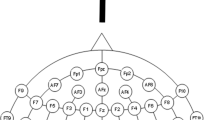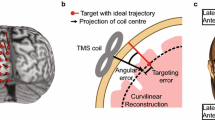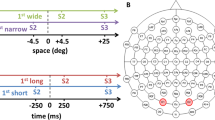Abstract
It is well known that, following an early visual deprivation, the neural network involved in processing auditory spatial information undergoes a profound reorganization. In particular, several studies have demonstrated an extensive activation of occipital brain areas, usually regarded as essentially “visual”, when early blind subjects (EB) performed a task that requires spatial processing of sounds. However, little is known about the possible consequences of the activation of occipitals area on the function of the large cortical network known, in sighted subjects, to be involved in the processing of auditory spatial information. To address this issue, we used event-related transcranial magnetic stimulation (TMS) to induce virtual lesions of either the right intra-parietal sulcus (rIPS) or the right dorsal extrastriate occipital cortex (rOC) at different delays in EB subjects performing a sound lateralization task. Surprisingly, TMS applied over rIPS, a region critically involved in the spatial processing of sound in sighted subjects, had no influence on the task performance in EB. In contrast, TMS applied over rOC 50 ms after sound onset, disrupted the spatial processing of sounds originating from the contralateral hemifield. The present study shed new lights on the reorganisation of the cortical network dedicated to the spatial processing of sounds in EB by showing an early contribution of rOC and a lesser involvement of rIPS.



Similar content being viewed by others
References
Allman BL, Keniston LP, Meredith MA (2008) Subthreshold auditory inputs to extrastriate visual neurons are responsive to parametric changes in stimulus quality: sensory-specific versus non-specific coding. Brain Res 1242:95–101
Amedi A, Floel A, Knecht S, Zohary E, Cohen LG (2004) Transcranial magnetic stimulation of the occipital pole interferes with verbal processing in blind subjects. Nat Neurosci 7:1266–1270
Andersen RA (1997) Multimodal integration for the representation of space in the posterior parietal cortex. Philos Trans R Soc Lond B Biol Sci 352:1421–1428
Andersen RA, Buneo CA (2002) Intentional maps in posterior parietal cortex. Annu Rev Neurosci 25:189–220
Arno P, De Volder AG, Vanlierde A, Wanet-Defalque MC, Streel E, Robert A, Sanabria-Bohorquez S, Veraart C (2001) Occipital activation by pattern recognition in the early blind using auditory substitution for vision. Neuroimage 13:632–645
Avillac M, Deneve S, Olivier E, Pouget A, Duhamel JR (2005) Reference frames for representing visual and tactile locations in parietal cortex. Nat Neurosci 8:941–949
Bavelier D, Neville HJ (2002) Cross-modal plasticity: where and how? Nat Rev Neurosci 3:443–452
Belmaker B, Fitzgerald P, George MS, Lisanby SH, Pascual-Leone A, Schlaepfer TE, Wassermann E (2003) Managing the risks of repetitive transcranial stimulation. CNS Spectr 8:489
Blauert J (1997) Spatial hearing: the psychophysics of human sound localization. MIT Press, Cambridge
Bremmer F, Schlack A, Shah NJ, Zafiris O, Kubischik M, Hoffmann K, Zilles K, Fink GR (2001) Polymodal motion processing in posterior parietal and promotor cortex: a human fMRI study strongly implies equivalencies between humans and monkeys. Neuron 29:287–296
Carriere BN, Royal DW, Perrault TJ, Morrison SP, Vaughan JW, Stein BE, Wallace MT (2007) Visual deprivation alters the development of cortical multisensory integration. J Neurophysiol 98:2858–2867
Cohen LG, Celnik P, Pascual-Leone A, Corwell B, Falz L, Dambrosia J, Honda M, Sadato N, Gerloff C, Catala MD, Hallett M (1997) Functional relevance of cross-modal plasticity in blind humans. Nature 389:180–183
Collignon O, Renier L, Bruyer R, Tranduy D, Veraart C (2006) Improved selective and divided spatial attention in early blind subjects. Brain Res 1075:175–182
Collignon O, Lassonde M, Lepore F, Bastien D, Veraart C (2007) Functional cerebral reorganization for auditory spatial processing and auditory substitution of vision in early blind subjects. Cereb Cortex 17:457–465
Collignon O, Davare M, De Volder AG, Poirier C, Olivier E, Veraart C (2008a) Time-course of posterior parietal and occipital cortex contribution to sound localization. J Cogn Neurosci 20:1454–1463
Collignon O, Voss P, Lassonde M, Lepore F (2008b) Cross-modal plasticity for the spatial processing of sounds in visually deprived subjects. Exp Brain Res 192(3):343–358
Davare M, Andres M, Cosnard G, Thonnard JL, Olivier E (2006) Dissociating the role of ventral and dorsal promotor cortex in precision grasping. J Neurosci 26:2260–2268
De Volder AG, Catalan-Ahumada M, Robert A, Bol A, Labar D, Coppens A, Michel C, Veraart C (1999) Changes in occipital cortex activity in early blind humans using a sensory substitution device. Brain Res 826:128–134
Eimer M (2001) Crossmodal links in spatial attention between vision, audition, and touch: evidence from event-related brain potentials. Neuropsychologia 39:1292–1303
Falchier A, Clavagnier S, Barone P, Kennedy H (2002) Anatomical evidence of multimodal integration in primate striate cortex. J Neurosci 22:5749–5759
Fishman MC, Michael P (1973) Integration of auditory information in the cat’s visual cortex. Vision Res 13:1415–1419
Giard MH, Peronnet F (1999) Auditory-visual integration during multimodal object recognition in humans: a behavioral and electrophysiological study. J Cogn Neurosci 11:473–490
Gougoux F, Zatorre RJ, Lassonde M, Voss P, Lepore F (2005) A functional neuroimaging study of sound localization: visual cortex activity predicts performance in early-blind individuals. PLoS Biol 3:e27
Grefkes C, Fink GR (2005) The functional organization of the intraparietal sulcus in humans and monkeys. J Anat 207:3–17
Griffiths TD, Rees G, Rees A, Green GG, Witton C, Rowe D, Buchel C, Turner R, Frackowiak RS (1998) Right parietal cortex is involved in the perception of sound movement in humans. Nat Neurosci 1:74–79
Haxby JV, Grady CL, Horwitz B, Ungerleider LG, Mishkin M, Carson RE, Herscovitch P, Schapiro MB, Rapoport SI (1991) Dissociation of object and spatial visual processing pathways in human extrastriate cortex. Proc Natl Acad Sci USA 88:1621–1625
Kennett S, Eimer M, Spence C, Driver J (2001) Tactile-visual links in exogenous spatial attention under different postures: convergent evidence from psychophysics and ERPs. J Cogn Neurosci 13:462–478
Kujala T, Alho K, Paavilainen P, Summala H, Naatanen R (1992) Neural plasticity in processing of sound location by the early blind: an event-related potential study. Electroencephalogr Clin Neurophysiol 84:469–472
Leclerc C, Saint-Amour D, Lavoie ME, Lassonde M, Lepore F (2000) Brain functional reorganization in early blind humans revealed by auditory event-related potentials. NeuroReport 11:545–550
Leclerc C, Segalowitz SJ, Desjardins J, Lassonde M, Lepore F (2005) EEG coherence in early-blind humans during sound localization. Neurosci Lett 376:154–159
Lewald J, Foltys H, Topper R (2002) Role of the posterior parietal cortex in spatial hearing. J Neurosci. 22: RC207
Lewald J, Meister IG, Weidemann J, Topper R (2004a) Involvement of the superior temporal cortex and the occipital cortex in spatial hearing: evidence from repetitive transcranial magnetic stimulation. J Cogn Neurosci 16:828–838
Lewald J, Wienemann M, Boroojerdi B (2004b) Shift in sound localization induced by rTMS of the posterior parietal lobe. Neuropsychologia 42:1598–1607
Merabet LB, Rizzo JF, Amedi A, Somers DC, Pascual-Leone A (2005) What blindness can tell us about seeing again: merging neuroplasticity and neuroprostheses. Nat Rev Neurosci 6:71–77
Molholm S, Ritter W, Murray MM, Javitt DC, Schroeder CE, Foxe JJ (2002) Multisensory auditory-visual interactions during early sensory processing in humans: a high-density electrical mapping study. Brain Res Cogn Brain Res 14:115–128
Morrell F (1972) Visual system’s view of acoustic space. Nature 238:44–46
Mullette-Gillman OA, Cohen YE, Groh JM (2005) Eye-centered, head-centered, and complex coding of visual and auditory targets in the intraparietal sulcus. J Neurophysiol 94:2331–2352
Noirhomme Q, Ferrant M, Vandermeeren Y, Olivier E, Macq B, Cuisenaire O (2004) Registration and real-time visualization of transcranial magnetic stimulation with 3-D MR images. IEEE Trans Biomed Eng 51:1994–2005
O’Shea J, Taylor PC, Rushworth MF (2008) Imaging causal interactions during sensorimotor processing. Cortex 44:598–608
Pascual-Leone A, Amedi A, Fregni F, Merabet LB (2005) The plastic human brain cortex. Annu Rev Neurosci 28:377–401
Piche M, Chabot N, Bronchti G, Miceli D, Lepore F, Guillemot JP (2007) Auditory responses in the visual cortex of neonatally enucleated rats. Neuroscience 145:1144–1156
Poirier C, Collignon O, de Volder AG, Renier L, Vanlierde A, Tranduy D, Scheiber C (2005) Specific activation of the V5 brain area by auditory motion processing: an fMRI study. Brain Res Cogn Brain Res 25:650–658
Poirier C, Collignon O, Scheiber C, Renier L, Vanlierde A, Tranduy D, Veraart C, De Volder AG (2006) Auditory motion perception activates visual motion areas in early blind subjects. Neuroimage 15:279–285
Rauschecker JP (1998) Parallel processing in the auditory cortex of primates. Audiol Neurootol 3:86–103
Rauschecker JP, Tian B (2000) Mechanisms and streams for processing of “what” and “where” in auditory cortex. Proc Natl Acad Sci USA 97:11800–11806
Roder B, Teder-Salejarvi W, Sterr A, Rosler F, Hillyard SA, Neville HJ (1999) Improved auditory spatial tuning in blind humans. Nature 400:162–166
Romanski LM, Tian B, Fritz J, Mishkin M, Goldman-Rakic PS, Rauschecker JP (1999) Dual streams of auditory afferents target multiple domains in the primate prefrontal cortex. Nat Neurosci 2:1131–1136
Schlack A, Sterbing-D’Angelo SJ, Hartung K, Hoffmann KP, Bremmer F (2005) Multisensory space representations in the macaque ventral intraparietal area. J Neurosci 25:4616–4625
Spence C, Driver J (2004) Crossmodal space and crossmodal attention. Oxford University Press, New York
Stricanne B, Andersen RA, Mazzoni P (1996) Eye-centered, head-centered, and intermediate coding of remembered sound locations in area LIP. J Neurophysiol 76:2071–2076
Vanlierde A, De Volder AG, Wanet-Defalque MC, Veraart C (2003) Occipito-parietal cortex activation during visuo-spatial imagery in early blind humans. Neuroimage 19:698–709
Voss P, Gougoux F, Zatorre RJ, Lassonde M, Lepore F (2008) Differential occipital responses in early- and late-blind individuals during a sound-source discrimination task. Neuroimage 40:746–758
Walsh V, Cowey A (2000) Transcranial magnetic stimulation and cognitive neuroscience. Nat Rev Neurosci 1:73–79
Wasserman EM, Greenberg BD, Murphy DL, Nguyen MB, Smith MJ (2000) A relationship between personality traits and cortical synaptic transmission measured with transcranial magnetic stimulation. Ann Neurol 48:420
Weeks RA, Aziz-Sultan A, Bushara KO, Tian B, Wessinger CM, Dang N, Rauschecker JP, Hallett M (1999) A PET study of human auditory spatial processing. Neurosci Lett 262:155–158
Weeks R, Horwitz B, Aziz-Sultan A, Tian B, Wessinger CM, Cohen LG, Hallett M, Rauschecker JP (2000) A positron emission tomographic study of auditory localization in the congenitally blind. J Neurosci 20:2664–2672
Zatorre RJ, Bouffard M, Ahad P, Belin P (2002) Where is ‘where’ in the human auditory cortex? Nat Neurosci 5:905–909
Zimmer U, Lewald J, Erb M, Grodd W, Karnath HO (2004) Is there a role of visual cortex in spatial hearing? Eur J Neurosci 20:3148–3156
Acknowledgements
We wish to thank the blind volunteers for their participation. Thanks are also due to C. Veraart for discussions and to B. Gerard for technical help. This experiment was supported by an FRSM Grant #3.4505.04 (ADV). ADV is senior research associate and MD and OC are postdoctoral researchers at the National Funds for Scientific Research (NFSR; Belgium).
Author information
Authors and Affiliations
Corresponding author
Additional information
This article is published as part of the Special Issue on Multisensory Integration.
Electronic supplementary material
Below is the link to the electronic supplementary material.
Rights and permissions
About this article
Cite this article
Collignon, O., Davare, M., Olivier, E. et al. Reorganisation of the Right Occipito-Parietal Stream for Auditory Spatial Processing in Early Blind Humans. A Transcranial Magnetic Stimulation Study. Brain Topogr 21, 232–240 (2009). https://doi.org/10.1007/s10548-009-0075-8
Received:
Accepted:
Published:
Issue Date:
DOI: https://doi.org/10.1007/s10548-009-0075-8




